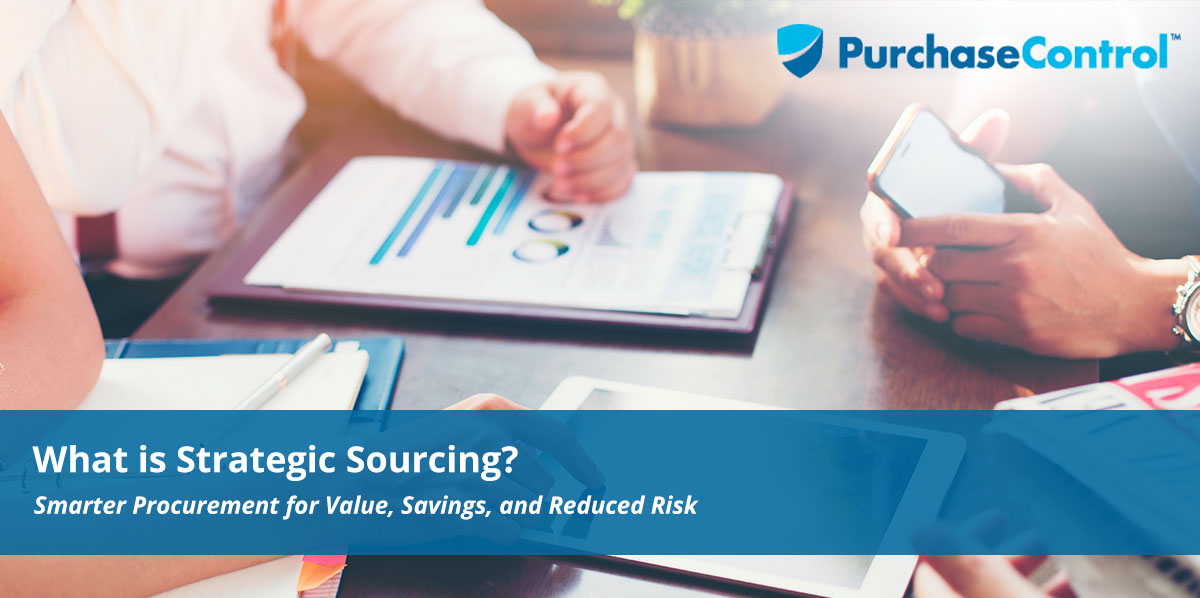When it’s healthy and well-optimized, your supply chain drives your company’s ability to produce the goods and services your customers need, with minimal disruptions and maximum value and savings for your company. And when disaster strikes, your supply chain management, supplier relationships, and sourcing strategies can mean the difference between weathering the storm and ending up on the rocks of financial ruin.
Strategic sourcing, supported by the right practices and tech tools, can help your company’s procurement department optimize essential procurement processes, develop a strong and diversified supplier base, and make sourcing decisions that ensure your business needs are met. And in doing so, you’ll insulate your company against risk and give it the agility it needs to navigate economic and supply chain disruptions to emerge strong, profitable, and ready for recovery.
What is Strategic Sourcing—and Why Does It Matter?
As its name implies, strategic sourcing is a formalized methodology for collecting, managing, and analyzing information in order to make intelligent, forward-thinking sourcing decisions. Companies leveraging strategic sourcing shift their focus away from traditional procurement processes and paradigms built on cost reductions and price points. They instead focus on maximum value generation, lowest possible total cost of ownership, and meeting their business needs and long-term goals while preserving business continuity and financial health in good times and bad.
Strategic sourcing is an iterative process. Every journey through its lifecycle provides a chance to improve performance, efficiency, savings, and value through continuous analysis and process optimization. Strategic sourcing focuses on a number of strategies, including:
- Diverse supply chains insulated against regional instabilities and potential geopolitical conflicts.
- Supply chain management that prioritizes logistical consistency and ease of access to essential raw materials and goods.
- High standards for legal, industry, and contractual compliance.
- Aggressive risk reduction through contingency planning, business process management, and data-driven analysis of not just price and availability, but vendor performance, market trends, governmental and industry regulatory changes, and other potential points of disruption.
- Investment in market research to ensure they are using environmentally and socially responsible practices and materials as a function of good corporate citizenship and as insulation against reputational damage or potentially unsafe or illegal materials and practices.
A strategic sourcing plan is flexible, resilient, and leverages data-based insights to generate and adapt contingency plans used to protect supply chain integrity, supplier relationships, and operational capabilities even in extreme scenarios such as war, pandemic, and natural disasters.
For example, the disastrous Amazon rainforest fires of 2019 were disruptive not only as natural disasters, but as a source of absolute devastation to the global supply market due to material loss, logistical issues, and political fallout.
So, too, did the coronavirus (COVID-19) pandemic prove to be a disaster in more ways than one. Quarantines and lockdowns restricted the availability of staff, raw materials, and access to production facilities. Companies around the world found their supply base disrupted, their customers absent, and their teams either struggling to adapt to remote collaboration or simply unable to work at all.
In both cases, procurement teams armed with contingency plans, centralized and optimized data management, and the capacity to preserve, restore, or modify their supply chains and purchasing behaviors had a distinct competitive advantage over those without. From redirecting their goods to new markets to proactively engaging with alternative vendors, companies with a strategic approach to sourcing were much better equipped to adapt.
That’s because procurement professionals leveraging strategic sourcing understand that these disasters, along with economic comorbidities like recession, unemployment, and civil unrest, may be unavoidable, but that doesn’t mean their potential to wound, cripple, or destroy businesses can’t be contained.
A typical strategic sourcing process generally follows a set number of steps:
- Supply Chain Assessment. In this step, procurement departments perform detailed spend analysis, evaluate and catalog all the products and materials used by the business (both directly, in the form of raw materials, and indirectly, such as office supplies), and record all suppliers, workflows, teams, and departments involved in the procure-to-pay (P2P) process.
- Strategic Development. The company crafts a sourcing strategy to fit its specific business goals for value creation, supplier relationship management, and overall productivity and business continuity. Contingency plans, including those that require alternative or emergency suppliers, are developed, along with key performance indicators (KPIs) for internal process efficiency, vendor performance and compliance, etc.
- Supplier Analysis. The company analyzes the current supplier market, earmarks criteria for suppliers that meet the needs established in step 2, and creates a portfolio of current and potential suppliers.
- Document Development. The company creates templates for crucial documents such as supplier onboarding agreements, purchase orders, request for information (RFI), request for proposal (RFP), and Request for Quotation (RFQ).
- Contract Negotiations. The company connects with approved vendors to negotiate optimal terms and conditions.
- Supplier Onboarding. Chosen suppliers are onboarded and integrated into P2P workflows, whether via formalized contractual agreements or outsourcing.
- Ongoing Performance Management. All KPIs are closely monitored and used to adjust the company’s sourcing strategy should circumstances warrant.
In today’s data-driven economy and society, deprecated practices and bottom line minded strategies simply aren’t enough to maintain or enhance competitive advantage and profitability. The global marketplace is vast, interconnected, and requires not only an understanding of why Big Data is important, but the intelligent and strategic analysis of that data to harvest the insights that will keep businesses operating when major disruptions arise.
It has come to be associated with large organizations with complex supply chains, but its principles can be leveraged by small businesses to achieve strategic improvements using the right tech tools.
“A strategic sourcing plan is flexible, resilient, and leverages data-based insights to generate and adapt contingency plans used to protect supply chain integrity, supplier relationships, and operational capabilities even in extreme scenarios such as war, pandemic, and natural disasters.”
Strategic Sourcing Begins with Procurement Software
Your procurement processes, risk management strategy, and sourcing strategy are all closely interrelated. Who you buy from is largely informed by what you need, how and when you need it, and the standards you set and follow for goods and services you both consume and produce. And in order to establish, monitor, and enforce these criteria in the age of digital transformation, you need the right tools.
Investing in a comprehensive, cloud-based, and AI-driven e-procurement solution like PurchaseControl gives your company a firm foundation for strategic sourcing in a number of ways.
For example:
- Artificial intelligence and advanced data analytics make collecting, managing, and analyzing all of your spend data much simpler.
- Process automation generates cost savings through greater efficiency and accuracy compared to paper-based, manual workflows. In addition, it provides added value generation by freeing staff to engage more directly in collaborative supplier relationship management.
- Full integration with existing software packages, along with vendor onboarding tools, allows for a completely transparent P2P process that:
- Supports electronic invoicing and automatic three-way matching.
- Eliminates rogue spend and invoice fraud.
- Provides on-demand, accurate data for smarter decision making, financial reporting and forecasting, and gleaning insights that can be used to further refine existing processes.
- Simplifies contract management.
- Allows for contingency-based, intelligent workflow changes to ensure supply chain integrity and operational continuity.
- Supports collaborative partnerships with preferred suppliers that can prove invaluable in breaking into new markets, developing new products, or achieving competitive advantage.
- Simplifies risk management and overall supply chain management by making it easier to track KPIs and adjust the supply chain, procurement processes, etc. as necessary.
In short, by automating and streamlining your procurement and centralizing your data management, you gain access to the information you need to make strategic decisions, the tools necessary to refine it further, and the technological enhancements necessary to maximize cost savings, reduce risk, and help shift your organization away from antiquated processes and toward greater agility in your supply chain and your company as a whole.
Strategic Sourcing Saves You More Than Just Money
The strongest supply chains aren’t those that never break, but those with the flexibility to bend and create new connections when it matters most. Choosing to prioritize strategic sourcing, and using the right software tools to do it, can help your company strengthen its supply chain, support your company’s goals for risk management, growth, and business continuity through process optimization, and ensure you have the resources you need to thrive when times are good and survive when disruptions come to call.
Make Smarter Purchases, Reduce Risk, and Build a More Strategic Supply Chain with PurchaseControl
Find Out How








